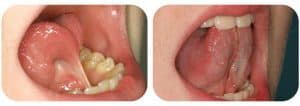When to get a Tongue Tie Release?
It is best to strengthen and train the tongue muscle with myofunctional therapy. And create more room in the mouth with a palatal expander, prior to doing a tongue tie release procedure. Otherwise the tongue will have no room to move and it will have no idea how to function. Usually 2-3 hours of myofunctional therapy and 2-6 months of palatal expander use will suffice. Every case is different and needs to be individually evaluated by a trained dentist and myofunctional therapist.
Tongue, lip and buccal tie release is also called frenectomy or frenuloplasty. Tongue tie is sometimes called ankylglossia by medical professionals.
Before and after tongue tie release procedure. The before photo is a very severe anterior tongue tie. Most tongue ties look like the picture below.
Tongue tie procedures require planning to avoid reattachment. Sometimes tongue tie releases need to be done in two phases to achieve optimal results. A delayed approach to tongue tie release is usually advised for optimal results. Untying a tongue will not automatically result in normal function. It is better two improve the strength and function of the tongue with myofunctional therapy prior to doing a release. The tongue is a complex muscle and it needs to be trained. Additionally, it is often better to improve the size and space in the mouth with a palatal expander. Many of the functional problems with the tongue are related to the mouth being too small. The tongue will be better able to function when there is space for it to move properly.
When are Tongue and Lip Tie Procedures necessary?
- airway issues such as airway resistance or sleep apnea
- Mouth breathing
- Snoring
- Teeth clenching and/or TMJ symptoms
- Bite problems
- Poor facial profile
- Poor posture related to airway or jaw underdevelopment
- Speech problems
- Swallowing problems
- Tongue thrust
- Neck and upper back pain and limited range of motion of the head and neck
When to get a Lip Tie Release
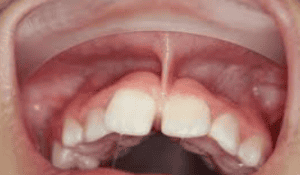
An upper lip tie is when the lip muscle attaches too tightly and too close to the teeth. Lip ties release should be performed right away. Lip ties are immediately restrictive and harmful and success rates are high with minimal other myofunctional treatments. Lip ties are the leading cause of poor forward growth. Upper lip ties prevent forward growth of the upper jaw by pulling too hard in reverse. Lower jaw forward growth cannot happen if the upper jaw does not grow first. One of the biggest mistakes is not removing lip ties and only focusing on lateral expansion.
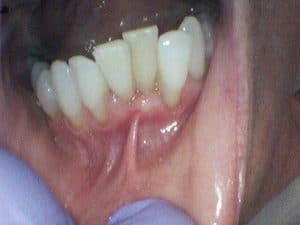
Lower Lip Tie
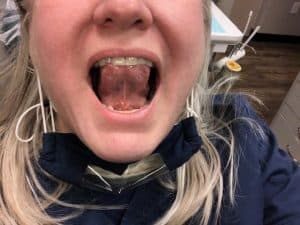
Posterior Tongue Tie
What is a Buccal Tie or Cheek Tie?
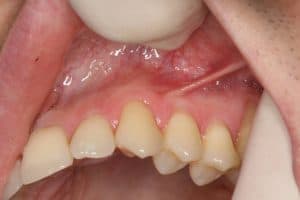
Buccal ties are also called cheek ties. Buccal ties are when the cheek muscles (masseter and pterygoid muscles) are attached too tightly and too close to the bicuspid and molar teeth. Buccal ties can cause gum recession, tipping inwards of the teeth. Buccal ties also cause the upper jaws to be narrow and the palate to be high. Most people with buccal ties need transverse palatal expansion. Buccal ties cause the upper jaw to grow less wide because of the reverse muscle pressure on the jaw bones. Buccal ties should be released along with lip ties and at the same time.
How to get prepared for tongue tie release procedure
Do not get a release without being evaluated by a certified myofunctional therapist. There needs to be a treatment plan to address structural issues with the jaws, bite and neck and back. Adult expanders such as the Homeoblock appliance and Vivos device can create more room in the mouth to improve the jaw structure and open up the airway.
Tongue and lip ties are muscle attachments that are too tight and restrict proper jaw and facial muscle function. Cutting the fascia is not going to automatically translate into the muscles working perfectly. It is also not going to address the problems caused by years of poor tongue and lip dysfunction.
Our protocol is palatal expanders, tongue and lip tie releases and myofunctional therapy. We also incorporate posture correction and breathing exercises. Not all our patients need all of this, but many do.

